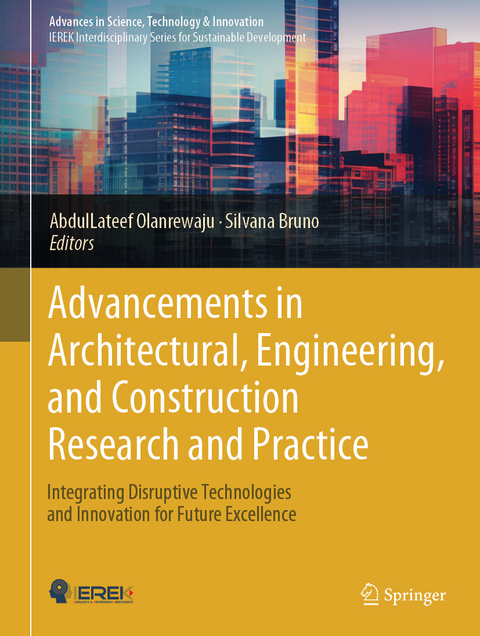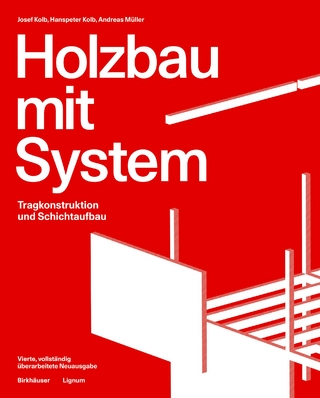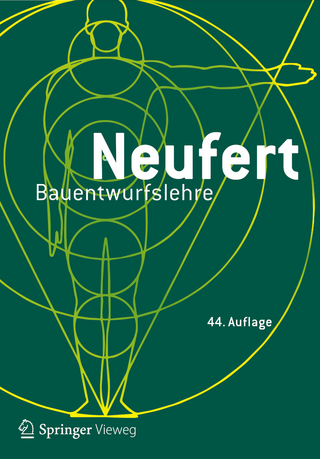
Advancements in Architectural, Engineering, and Construction Research and Practice
Springer International Publishing (Verlag)
978-3-031-59328-4 (ISBN)
This book offers a captivating discussion into the cutting-edge developments at the intersection of architecture, engineering, construction, and technology. With a focus on the power of big data analytics and computational design, this book delves into the transformative potential of these domains in shaping the built environment and business.
This book discovers the fusion of architectural and engineering innovations with the capabilities of big data analytics, machine learning, and AI and explores how this parallelism is revolutionizing the design process, enhancing efficiency, and opening new horizons for creativity.
This book steps into a world where predictive models, statistical algorithms, and what-if scenarios drive advancements in architectural and engineering practices and witnesses the seamless integration of technology in design generation, data visualization, task automation, and performance testing.
It is an essential read for researchers and professionals seeking to leverage the potential of big data analytics to transform the built environment, maintaining the central role of humans.
Abdullateef Olanrewaju: His first employment in the construction industry was as a quantity surveyor, about 15 years ago. He was involved in various construction projects from conceptual stage to completion. He has managed construction projects for multinational companies, private and public clients in Nigeria. He gained his master of science in the built environment from the International Islamic University Malaysia (IIUM) for his research in value management and his doctorate from Universiti Teknologi PETRONAS Malaysia for his research in building maintenance management. Most of his researches are grounded in data because he is an empiricist researcher that likes to understand relationship from the data obtained. His academic activities center on lecturing and research associated with building maintenance, building economics, housing, sustainable buildings and value management. He has authored and co- authored several scientific papers. Olanrewaju is a referee for leading journals; Construction Management and Economics, International Journal of Construction Management, Engineering, Facilities and Construction and Architectural Management. He has served has as panelist and keynote speaker on different topics relating to building maintenance and the construction sector. He is supervising Ph. D. and MSc students. Based on a previous funded research, he has developed a 'Building sustainable maintenance management model' to guide designers, developers and policy makers in the Malaysian real estate market. His latest book: "Building Maintenance Processes and Practices" publisher by Springer is one of the most downloaded books based on the latest report. He is currently holding two federal government sponsored researches on affordable housing. His university sponsored research on development of schemes to deliver sustainable housing is nearing completion. His current research concentrates on sustainable maintenance management, housing delivery, ethical issues in construction and roles of construction sector in economic development and the procurements of construction projects through the Shariah method. Silvana Bruno: Building Engineer, Architect and PhD in Risk and environmental, territorial and building development (Architectural Engineering and Construction Management), Research Fellow in Architectural Engineering at Polytechnic University of Bari. Investigation topics concern digital technologies for heritage knowledge and conservation (BIM, Virtual Reality and Digital Twins), studies about urban heat island and mitigation strategies, implementation of virtual environments for risk assessment and communication. Assistant professor in "Building sustainability" and researcher in the project "Eco-Design strategies: from materials to Product Service Systems - PSS), to develop new solutions and materials with high performance towards environmental sustainability and circularity in the use of resources (funding PNRR, Mission 4 Component 2 - 1.3 "Partenariati estesi" su PE11 «3 A -ITALY» financed by European Community - NextGenerationEU" - Spoke 2).
Part I :Parallels in Built Environment: managing cities and buildings with Artificial Intelligence and Distributed Computing: Chapter 1. Smart Cities and Technology: The Role of Digital Technology in The Urban Fabric .- Chapter 2. Use of Advanced Digital Technologies in Re-Presentation of an Ottoman Caravanserai and its Surrounding Historic Built Environment, in Bursa, Turkey.- Chapter 3. A Metaheuristic-Based Subspace Search Approach for Outlier Detection in High Dimensional Data Streams.- Chapter 4 Artificial intelligence and crowd-sourced social media data for biodiversity monitoring and conservation .- Part II : Parallels In Architectural design: new perspectives, workflows and tools involving robotics and Artificial Intelligence: Chapter 5. Client Brief to 3D Printed Construction - an Artificial Intelligence Workflow for Architectural AI Design Process.- Chapter 6. Sketch Plan Recognition and Vectorization of Floor Plan Sketches for BIM Design Environment.- Chapter 7.Enhancing Architectural Plan Generation with Machine Learning and Space Syntax Analysis for Optimized Spatial Configuration.- Chapter 8. Machine learning based QSAR classifications for PIM kinases inhibition prediction : Towards the neoplastic insilico drug design.- Part III: Parallels In Performance Assessment: Energetic and Structural analysis aided by Computing Techniques. Chapter 9.Calculating Cost Optimal Energy Efficiency Levels for Opening Elements on an Exemplar Residential Building.- Chapter 10. The Effect of Urban Design for Residential Complexes on the Efficiency of Environmental Performance and Carbon Emissions.- Chapter 11 Influence of Embedded Crack on the Mechanical Failure of TI-6AI-4V Locking Compression Plates Using Finite Element Analysis .- Chapter 12. Analysis of the impact of new singular ventilation technologies on enhancing indoor air quality in schools. Part IV: Disruptive Business Models and Innovative Market Strategies: Digital Marketing and social innovations. Chapter 13. Shaping disruptive solutions for sustainable futures: zooming in on the social in socio-technical transformation.- Chapter 14 Unveiling the Complexities of Purchaser Retention in Non-Fungible Token (NFT) Platforms: Investigating Direct, Strengthening, and Constraining Moderating Factors for Single and Multiple NFT Purchasers.- Chapter 15. Exploring Determining Factors for SMEs' Access to Alternative Financing Through the Technology-Organization-Environment (TOE) Framework .- Chapter 16. Into the Secret Garden or a Dark Pool? An Exploration of whether DeFi Gardens/Pools Provide a viable democratic alternative to Principal-agent Investment.- Chapter 17. The Nature Smart Future - In Search for the Next Gen Innovation.
| Erscheinungsdatum | 05.10.2024 |
|---|---|
| Reihe/Serie | Advances in Science, Technology & Innovation |
| Zusatzinfo | XIV, 214 p. 139 illus., 116 illus. in color. |
| Verlagsort | Cham |
| Sprache | englisch |
| Maße | 210 x 279 mm |
| Themenwelt | Technik ► Architektur |
| Technik ► Bauwesen | |
| Schlagworte | computer visions • Data-Driven Computation • Disruptive Technologies in Climate Change • Disruptive Technologies in Climate Change • Disruptive Technologies in Creating Circular Economies • Environmental Sustainability in Business • Ethical And Social Considerations • Gamafication Techniques • Machine Learning and Artifical Intelligence |
| ISBN-10 | 3-031-59328-6 / 3031593286 |
| ISBN-13 | 978-3-031-59328-4 / 9783031593284 |
| Zustand | Neuware |
| Informationen gemäß Produktsicherheitsverordnung (GPSR) | |
| Haben Sie eine Frage zum Produkt? |
aus dem Bereich


